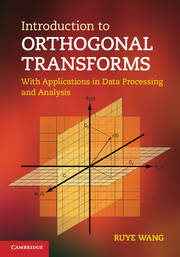Book contents
- Frontmatter
- Contents
- Preface
- Acknowledgments
- Notation
- 1 Signals and systems
- 2 Vector spaces and signal representation
- 3 Continuous-time Fourier transform
- 4 Discrete-time Fourier transform
- 5 Applications of the Fourier transforms
- 6 The Laplace and z-transforms
- 7 Fourier-related orthogonal transforms
- 8 The Walsh-Hadamard, slant, and Haar transforms
- 9 Karhunen-Loève transform and principal component analysis
- 10 Continuous- and discrete-time wavelet transforms
- 11 Multiresolution analysis and discrete wavelet transform
- Appendices
- Bibliography
- Index
Preface
Published online by Cambridge University Press: 05 October 2012
- Frontmatter
- Contents
- Preface
- Acknowledgments
- Notation
- 1 Signals and systems
- 2 Vector spaces and signal representation
- 3 Continuous-time Fourier transform
- 4 Discrete-time Fourier transform
- 5 Applications of the Fourier transforms
- 6 The Laplace and z-transforms
- 7 Fourier-related orthogonal transforms
- 8 The Walsh-Hadamard, slant, and Haar transforms
- 9 Karhunen-Loève transform and principal component analysis
- 10 Continuous- and discrete-time wavelet transforms
- 11 Multiresolution analysis and discrete wavelet transform
- Appendices
- Bibliography
- Index
Summary
What is the book all about?
When a straight line standing on a straight line makes the adjacent angles equal to one another, each of the equal angles is right, and the straight line standing on the other is called a perpendicular to that on which it stands.
— Euclid, Elements, Book 1, definition 10This is Euclid's definition for “perpendicular”, which is synonymous with the word “orthogonal” used in the title of this book. Although the meaning of this word has been generalized since Euclid's time to describe the relationship between two functions as well as two vectors, as what we will be mostly concerned with in this book, they are essentially no different from two perpendicular straight lines, as discussed by Euclid some 23 centuries ago.
Orthogonality is of important significance not only in geometry and mathematics, but also in science and engineering in general, and in data processing and analysis in particular. This book is about a set of mathematical and computational methods, known collectively as the orthogonal transforms, that enables us to take advantage of the orthogonal axes of the space in which the data reside. As we will see throughout the book, such orthogonality is a much desired property that can keep things untangled and nicely separated for ease of manipulation, and an orthogonal transform can rotate a signal, represented as a vector in a Euclidean space, or more generally Hilbert space, in such a way that the signal components tend to become, approximately or accurately, orthogonal to each other.
Information
- Type
- Chapter
- Information
- Introduction to Orthogonal TransformsWith Applications in Data Processing and Analysis, pp. xii - xixPublisher: Cambridge University PressPrint publication year: 2012
Accessibility standard: Unknown
Why this information is here
This section outlines the accessibility features of this content - including support for screen readers, full keyboard navigation and high-contrast display options. This may not be relevant for you.Accessibility Information
- 1
- Cited by
